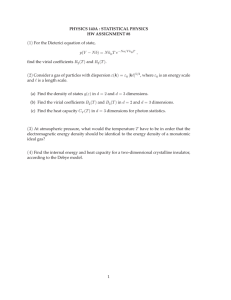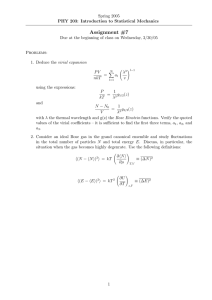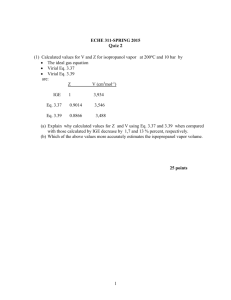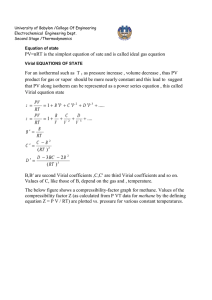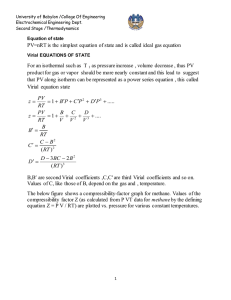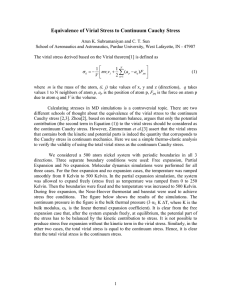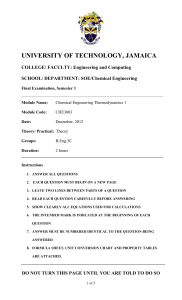Accepted Manuscript
advertisement
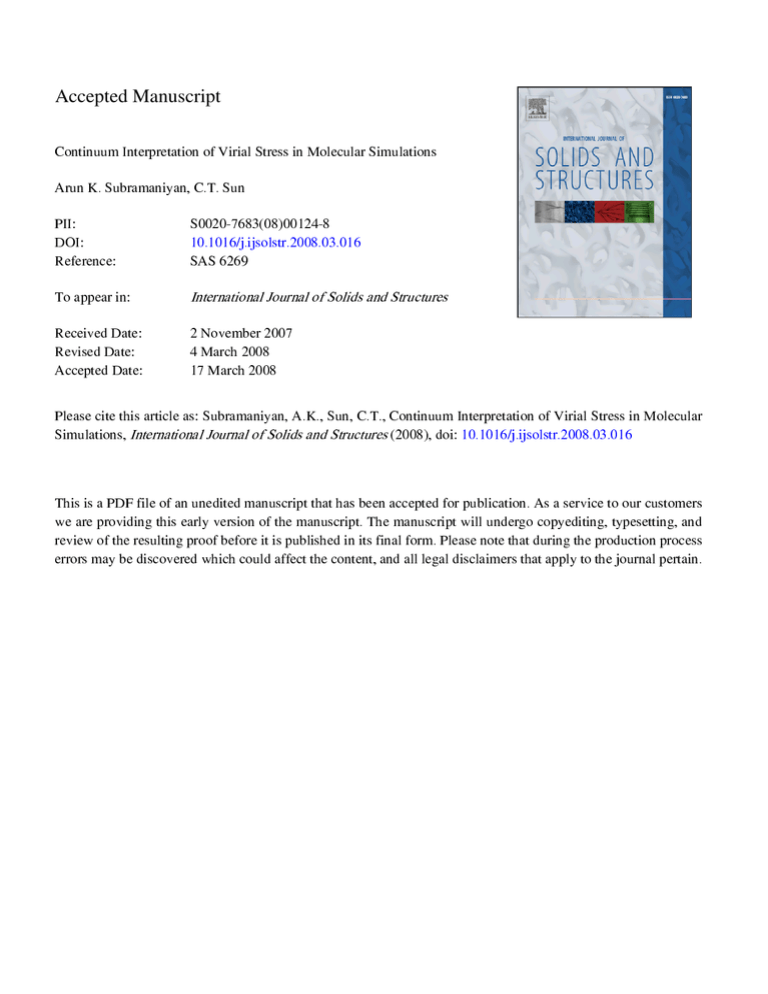
Accepted Manuscript Continuum Interpretation of Virial Stress in Molecular Simulations Arun K. Subramaniyan, C.T. Sun PII: DOI: Reference: S0020-7683(08)00124-8 10.1016/j.ijsolstr.2008.03.016 SAS 6269 To appear in: International Journal of Solids and Structures Received Date: Revised Date: Accepted Date: 2 November 2007 4 March 2008 17 March 2008 Please cite this article as: Subramaniyan, A.K., Sun, C.T., Continuum Interpretation of Virial Stress in Molecular Simulations, (2008), doi: 10.1016/j.ijsolstr.2008.03.016 International Journal of Solids and Structures This is a PDF file of an unedited manuscript that has been accepted for publication. As a service to our customers we are providing this early version of the manuscript. The manuscript will undergo copyediting, typesetting, and review of the resulting proof before it is published in its final form. Please note that during the production process errors may be discovered which could affect the content, and all legal disclaimers that apply to the journal pertain. ACCEPTED MANUSCRIPT Continuum Interpretation of Virial Stress in Molecular Simulations Arun K. Subramaniyan and C. T. Sun* Purdue University, West Lafayette, IN – 47907. SC R Abstract IP T School of Aeronautics and Astronautics, The equivalence of the virial stress and Cauchy stress is reviewed using both theoretical arguments and numerical simulations. Using thermoelasticity problems as NU examples, we numerically demonstrate that virial stress is equivalent to the continuum Cauchy stress. Neglecting the velocity terms in the definition of virial stress as many MA authors have recently suggested, can cause significant errors in interpreting MD simulation results at elevated temperatures (T > 0 K). D 1. Introduction TE With the advent of nanotechnology, molecular simulations have become an indispensable tool for scientists and engineers alike. There has been a recent surge of EP interest in multiscale modeling to understand molecular and continuum scale phenomena concurrently (Gates et al., 2005). Before tackling the scale bridging problem, we need AC C definitions for the fundamental quantities such as stress that are equivalent in both macro and nano scales. Equivalent definitions of the stress at the atomic level are usually developed using balance equations and long-wavelength (and long time) averages. Zimmerman et al. (2004) noted that the instantaneous atomic values for quantities such as * Corresponding Author. Tel.: +1 765 494 5130; fax: +1 765 494 0307. E-mail address: sun@purdue.edu (C.T. Sun). 1 ACCEPTED MANUSCRIPT stress should not be used as an equivalent continuum (Cauchy) stress. Doing so will produce erroneous results even in the most simplest of cases as shown by many researchers (Tsai, 1979, Cheung and Yip, 1991, Chen, 2006). Several definitions have IP T been developed to calculate the local atomic stress. Irving and Kirkwood (1950), Tsai (1979), Cheung and Yip (1991), Lutsko (1988), Cormier et al. (2001) and Hardy (1981) SC R developed alternative definitions for local atomic stress. A detailed discussion was given by Zimmerman et al. (2004). NU The subject of this article is the virial stress and not the local atomic stress. The virial stress developed based on the virial theorem of Clausius (1870) and Maxwell ijV MA (1870) is shown below (Swenson, 1983, Tsai, 1979). 1 N 1 ( Ri Ri ) Fj m vi v j V 2 1 (1) D where (i, j) take values of x, y and z (directions), takes values 1 to N neighbors of TE atom , Ri is the position of atom along direction i, Fj is the force (along direction j) on atom due to atom , V is the total volume, m is the mass of atom EP and v is the thermal excitation velocity of atom . Note that the term Fj is uniquely AC C defined only for pair potentials and EAM type potentials (Zimmerman et al., 2004). The above definition of virial stress involves the instantaneous velocities only due to thermal fluctuation. The virial stress calculated from molecular dynamics (MD) simulations has to be averaged over time in order for it to be equivalent to the continuum 2 ACCEPTED MANUSCRIPT Cauchy stress. A succinct and thorough collection of definitions for virial stress for various cases is given by Smith (1993). Note that there is ambiguity only when the point (atomic) wise virial stress is used as an equivalent continuum measure as noted by IP T Zimmerman et al. (2004) and not the average value of the virial stress. SC R Recently, a controversy was started in an article by Zhou (2003), in which he tried to prove by examples that virial stress (including the velocity terms) is not equivalent to Cauchy stress. Zhou uses many examples to support his argument. However, most of NU those examples are flawed. Dommelen (2003), in his unpublished paper has clearly pointed out the error in Zhou's examples. We would like to reiterate that contrary to what MA is claimed by Zhou, virial stress is indeed an atomistic definition for stress that is equivalent to the continuum Cauchy stress. We will show using numerical examples that it is indeed the mechanical stress as long as proper spatial and temporal averages are TE D taken in an Eulerian reference frame. Many researchers accepted Zhou’s conclusions and derived their own equivalent EP stress definitions (Shen and Atluri, 2004, Andia et al., 2006) without the velocity term. Several others (Sun et al., 2006, Tschopp et al., 2007, Lu and Bhattacharya, 2005) AC C including a course note from the MIT website (Buehler, 2005) cite Zhou’s article as a reason for using just the potential part of virial stress as mechanical stress. One of the main objectives of this article is to provide evidence that using only the potential part of virial stress in MD simulations as Cauchy stress is not correct. 3 ACCEPTED MANUSCRIPT Andia et al. (2006), have taken a Lagrangian frame of reference to show that the stress in the atomic system does not contain velocity terms. However, this result is well known. For example, Gao and Weiner (1987) clearly show that the dynamic term is IP T included only in an Eulerian (spatial) reference frame and not in a Lagrangian frame of reference. Gao and Weiner (1987) also show the equivalence between the Eulerian SC R (spatial) and the Lagrangian (material) definitions of virial stress. The error in Andia et al. (2006) is in extending their Lagrangian framework for stress calculation in MD simulations. MD simulations are typically performed in the Eulerian reference frame and NU hence will need to have velocity included in the stress definition. In the rare case when a Lagrangian reference frame is used, care must be taken to modify the equations of motion MA accordingly as described in later sections to follow (section 3.1). We think it is desirable to point out this anomaly because ignoring the dynamic terms causes significant errors in D stress obtained via MD simulations. Multiple examples are given to prove the point. TE The rest of this article is organized as follows. Details and the results of a number of thermoelastic simulations are given in Section 2. Some fundamental characteristics of EP virial stress in molecular simulations are discussed in Section 3 and the necessity of AC C kinetic part of virial stress to completely define mechanical stress is shown. 4 ACCEPTED MANUSCRIPT 2. Thermoelastic Study 2.1 A Thermoelastic analogy Swenson, 1983) is defined as (Tsai, 1979) 1 N 1 ( Ri Ri ) Fj nd k BT V 2 1 SC R ijV IP T The virial stress derived based on the virial theorem (Marc and McMillan, 1985, (2) where nd is the number of degrees of freedom, k B is the Boltzmann constant, T is the NU temperature and all other quantities are the same as defined earlier. Note that the usual form has Ri Ri with both the first and second parts of the right hand side having the MA same sign. We have rearranged it to highlight the analogy to the thermo-elastic definition of Cauchy stress. Using the temperature-velocity relation (Lee et al., 1973) on Equation D (2), we obtain the virial stress expression given in Equation (1). TE Comparing Equations (1) and (2), it is clear that the velocity in the virial stress EP definition is only the thermal excitation velocity and not the total velocity of the atoms. AC C Rewriting the above virial stress, we have ijV 1 V P ij ijK where ijP is the potential part and ijK is the kinetic part. 5 (3) ACCEPTED MANUSCRIPT Consider the simple case of an isotropic linear elastic material subjected to a temperature change T along with elastic deformation. Cauchy stress can be calculated ij ijG 3 2 i T ij IP T using uncoupled thermoelasticity as (4) where ijG 2 ij kk ij , & are Lame’s constants, i is the coefficient of linear SC R thermal expansion and ij is the Kronecker delta function. The similarity between the thermoelastic definition of stress and the virial stress is striking. A word of caution is necessary here. We do not claim that the right hand side terms in Equations (3) and (4) NU are equivalent individually; they are not. There is a subtle difference between the two terms (on the right hand side) in Equations (3) and (4) that is usually missed (or MA misinterpreted). We will clarify the difference below. D In the continuum thermoelastic definition (Equation (4)), the first part ijG is the TE stress produced due to both thermal and elastic deformations. The second part is the total thermal stress which would be produced if we do not allow the body to expand or EP contract in response to the temperature change. In the virial stress definition (Equation (3)), the kinetic part of stress K is part of the thermal stress (not total) that would AC C develop in a constrained system subjected to a temperature change. This is the main difference between Equations (3) and (4). It is interesting to note that in molecular dynamics (MD) simulations of condensed matter systems, most of the thermal stress is produced by the potential part P . This is because the interatomic potential is not temperature dependent. Hence, in the virial stress definition, the thermal stress has 6 ACCEPTED MANUSCRIPT contributions from both the potential term and the kinetic term. We will show that the sum of the potential and kinetic parts (i.e., not the potential part alone) gives the Cauchy IP T stress. 2.2 Thermal Expansion in Molecular Dynamics (MD) Simulations SC R We have stated above that the thermal stress in MD simulations is comprised of both kinetic and potential parts. It is easier to understand this by looking at the mechanism responsible for thermal expansion in MD simulations. Thermal expansion is NU an anharmonic phenomenon (Kittel, 1996, Girifalco, 1973). It is well known that at temperatures above absolute zero (0 Kelvin), atoms vibrate about their mean positions MA due to thermal activation (Kittel, 1996, Lee et al., 1973). In MD simulations, when the interaction of the atoms is described by an anharmonic potential, the anharmonicity in the inter-atomic potential causes the mean position between atoms to change, thus causing D thermal expansion (or contraction). In theory the above description is true. However, EP MD simulations. TE some additional details are necessary to completely describe the phenomena modeled in The majority of the interatomic potentials used in MD simulations are AC C temperature independent. Thermal expansion is produced by an intricate combination of the interatomic forces and velocity (due to temperature) interacting via the equations of motion. The contribution of the potential part to the total stress may vary greatly depending on the state of thermal equilibrium of the system. To illustrate this effect, we 7 ACCEPTED MANUSCRIPT subjected a nickel system to various thermoelastic loadings. The details of the simulations follow. IP T The classical MD simulation code LAMMPS (Plimpton, 1995) from Sandia National Labs was used for all simulations in this article. A 500 atom nickel system was SC R used for all subsequent simulations. The simulation box was oriented along [1 0 0], [0 1 0] and [0 0 1] directions. Periodic boundary conditions were applied along all boundaries. EAM (embedded atom) potentials (Daw et al., 1993, Foiles et al., 1986) were NU used to describe the interaction between the nickel atoms. A time step of 1 fs was used in all simulations. The system was equilibrated at a temperature of 2 K (very low MA temperature) to stress free conditions using the isothermal-isobaric (NPT) and microcanonical (NVE) ensembles for 40 ps. After the initial equilibration, temperature was gradually increased using velocity rescaling under NVE for 50 ps. Since raising D temperature results in a non-equilibrium process, a further 10 ps of equilibration was TE performed under NVE with temperature fixed at 500 K. The system was then allowed to expand freely to achieve stress-free thermal equilibrium under NPT for 50 ps. The EP velocity rescaling was removed and the system was equilibrated for 10 ps under NPT AC C followed by NVE dynamics of 50 ps for data collection. The thermodynamic variables, viz., temperature, potential energy, kinetic energy and total energy trajectories are plotted in Figure 1. Clearly, the solution has converged during all stages of the simulations. The colors correspond to the various ensembles described above. A legend is included in Figure 2 for completeness. We also monitored 8 ACCEPTED MANUSCRIPT the potential and kinetic parts of the virial stress during the entire simulation. The normal components along [0 1 0] direction are shown in Figure 2. Stresses in other directions TE D MA NU SC R IP T show similar trends. EP Figure 1: Evolution of thermodynamic quantities during the thermal loading of a nickel system, (a) temperature (b) potential energy (c) kinetic energy and (d) total energy. All AC C quantities are plotted against time in pico seconds. It is interesting to note (from Figure 2) that when the system is not allowed to expand, the potential contribution to the total stress is about 5/6ths (the ratio depends on the material and the temperature). This huge potential stress is responsible for the 9 ACCEPTED MANUSCRIPT expansion when the system moves to stress free thermal equilibrium at the set temperature. Once the system reaches stress free thermal equilibrium, the potential contribution to the stress is exactly equal to the kinetic contribution (with opposite sign). IP T This potential stress is produced because the inter-atomic potential is temperature independent. As shown in Figure 3, the interatomic force at thermal equilibrium may be SC R zero only when the potential is temperature dependent. Hence, kinetic contribution to the stress is essential to maintain stress free thermal equilibrium. It is thus clear that the total virial stress (including both the potential and kinetic contributions) is indeed equivalent to NU Cauchy stress. Even at such moderate temperatures, the velocity part of the stress is 600 AC C EP TE D MA MPa, which is not negligible under most circumstances. Figure 2: Kinetic and potential parts of the dynamically evolving virial stress due to thermal loading. The legend corresponds to the following ensembles: (a) NVE at 2 K (b) NVE with increasing temperature (c) NVE at 500 K (d) NPT at 500 K (e) NPT without temperature rescaling and (f) NVE without temperature rescaling. 10 SC R IP T ACCEPTED MANUSCRIPT Figure 3: Variation of inter-atomic forces with temperature in temperature independent MA NU and temperature dependent potentials (F is the interatomic force). 2.3 Additional thermal loading To reiterate the numerical equivalence of virial stress to Cauchy stress, some D more thermoelastic MD simulations of the nickel system were performed. Three separate TE boundary conditions were considered: free (full expansion), fixed (no expansion) and partially free (partial expansion). In the fixed case, all boundaries were fixed and the EP system was equilibrated at 500 K under NVE for 150 ps. Similarly, for free expansion, the system was allowed to relax (stress-free) at 500 K under NPT for 150 ps. In the case AC C of partial expansion, the system was first heated to 250 K and allowed to freely expand under NPT for 150 ps. After stress free expansion (at 250 K), all boundaries were fixed and the temperature was increased to 500 K. The system was then equilibrated under NVE for 100 ps at 500K. 11 ACCEPTED MANUSCRIPT In all the above cases, the kinetic and potential contributions of the virial stress were monitored. To compare the MD results with Cauchy stress, we also calculated the bulk modulus of the nickel system using MD simulations. The bulk modulus was IP T calculated by subjecting the nickel system to a bulk strain of 0.75 % in increments of 0.25 % (engineering strain). Figure 4 shows a comparison of the stresses in all three cases SC R considered. The continuum stress is the bulk thermal stress (Cauchy stress) which was calculated using 3 L K T , where L is the coefficient of linear thermal expansion NU (13.5 106 / o K ) (Toloukian et al., 1975), K is the bulk modulus and T is the temperature. MA The average pressures (negative trace of the stress tensor) for all cases are plotted in Figure 4. The results in Figure 4 clearly prove beyond any doubt that the total virial stress is indeed the Cauchy stress (when appropriate averages are taken). Clearly in the D free expansion case, without the velocity part of the virial stress, one cannot achieve TE stress-free expansion. In both no expansion and partial expansion cases, the total virial stress corresponds to the Cauchy stress. In the moderate temperature range considered, EP using the potential part of the virial stress without the kinetic contribution results in 15 – AC C 35% error. These errors are by no means negligible. 12 NU SC R IP T ACCEPTED MANUSCRIPT Figure 4: Comparing the kinetic and potential contributions of virial stress to continuum MA bulk stress. D 3. Discussion TE 3.1 Fundamental issues with neglecting kinetic contribution to virial stress The Nose-Hoover NPT dynamics uses a coupled external bath to control pressure EP (Nosé and Klein, 1983). NPT and NPH ensembles rely on the stress tensor to adjust the simulation box size for pressure control (Andersen, 1980, Parrinello and Rahman, 1981). AC C The relevant modified governing equation for volume change (pressure control terms in Melchionna modification) of an isotropic system is given below (Melchionna et al., 1993, Smith et al., 2003): d (t ) 1 V (t ) P Pext dt Nk BText p2 13 (5) ACCEPTED MANUSCRIPT where N is the total number of atoms, kB is the Boltzmann constant, V(t) is the volume of the system, Pext is the external applied pressure, P is the internal pressure (negative of total virial stress), (t ) is an additional degree of freedom to control pressure, p is the IP T time parameter for pressure control. SC R Note that P is the total virial stress and the external pressure Pext is a continuum representation. Hence, the equivalence between the virial and continuum stresses is implicit in the MD simulation algorithm. Thus the interpretation of Cauchy stress to be NU just the potential part of the virial stress is flawed. Furthermore, if Equation (5) is modified with only the potential part of the virial stress, then the results of the MD MA simulation will be in error. This can be seen clearly by performing a simple thermal expansion calculation using the potential part of the virial stress in Equation (5). D 3.2 Conditions for using the kinetic part of virial stress TE One of the main conditions for using the kinetic terms in the virial stress is that the mean velocity be removed from the velocity used to calculate stress. Otherwise, even EP a rigid body motion would produce stress. Another equally important and necessary condition is averaging. Proper spatial and temporal averages of the virial stress have to be AC C taken in order for it to be equivalent to the Cauchy stress. A special case where the kinetic part in the virial stress is unnecessary is when we consider a Lagrangian frame of reference (i.e., atoms do not cross the periodic boundary). In a Lagrangian reference frame, the velocity term should not be included (Gao and 14 ACCEPTED MANUSCRIPT Weiner, 1987, Andia et al., 2006). In this case, care must be taken to ensure that the pressure tensor in the modified Nose-Hoover equations (Equation (5)) does not contain IP T the velocity term as well. Zimmerman et al. (2004) have clearly pointed out the issues in using the virial SC R stress as a continuum point stress directly. They have also suggested alternatives like the Hardy formulation that can be used in a point wise manner. However, note that the issue is with using virial stress to calculate instantaneous values for stress at an atomic point. NU As shown in this article, there is no ambiguity about the definition of virial stress as a time and spatially averaged quantity. In the ensemble average, the total virial stress is MA indeed the Cauchy stress. 4. Summary D Using thermo-elastic analysis, we have numerically shown that appropriately TE averaged (spatial and temporal) virial stress is indeed the Cauchy stress. The examples prove that the kinetic term in the virial stress is necessary to interpret virial stress as EP Cauchy stress in MD simulations. A simple case of stress free thermal expansion clearly shows beyond any doubt that without the kinetic part of the virial stress, it is impossible AC C to compute a stress in the atomic system that comes anywhere near the expected continuum value. It was reiterated that the kinetic part of virial stress contains only the thermal excitation velocity. It has been clearly shown that potential part of the virial stress does not constitute the total mechanical stress at elevated temperatures (T > 0 K). Neglecting the kinetic part of the virial stress, as suggested by some researchers, will 15 ACCEPTED MANUSCRIPT cause significant errors even in solids. The implicit assumption inherent in molecular dynamics simulations about the equivalence of virial stress and Cauchy stress was highlighted. Thus, the confusion about the correct interpretation of virial stress as Cauchy AC C EP TE D MA NU SC R IP T stress in MD simulations has been cleared. 16 ACCEPTED MANUSCRIPT Acknowledgements We are thankful to the support in part by the Office of Naval Research (ONR), grant no. AC C EP TE D MA NU SC R IP T N00014-1-0552. The technical monitor was Dr. Yapa D.S. Rajapakse. 17 ACCEPTED MANUSCRIPT IP T References AC C EP TE D MA NU SC R Andersen, H.C., 1980. Molecular dynamics simulations at constant pressure and/or temperature. Journal of Chemical Physics 74, 2384-2393. Andia, P.C., Costanzo, F., Gray, G.L., 2006. A classical mechanics approach to the determination of the stress & strain response of particle systems. Modelling and Simulation in Materials Science and Engineering 14, 741-757. Buehler, M.J. 2005 From nano to macro: Introduction to atomistic modeling techniques. http://web.mit.edu/mbuehler/www/Teaching/LS/lecture_1_nano-macrobuehler.pdf, Lecture Series, Department of Civil and Environmental Engineering, MIT Chen, Y., 2006. Local stress and heat flux in atomistic systems involving three-body forces. Journal of Chemical Physics 124, 054113. Cheung, K.S., Yip, S., 1991. Atomic-level stress in an inhomogeneous system. Journal of Applied Physics 70, 5688-5690. Clausius, R.J.E., 1870. On a mechanical theorem applicable to heat. Philosophical Magazine 40, 122-127. Cormier, J., Rickman, J.M., Delph, T.J., 2001. Stress calculation in atomistic simulations of perfect and imperfect solids. Journal of Applied Physics 89, 99-104. Daw, M.S., Foiles, S.M., Baskes, M.I., 1993. The embedded-atom method: a review of theory and applications. Materials Science Reports 9, 251-310. Dommelen, L. V. 2003 Physical interpretation of the virial stress, http://www.eng.fsu.edu/~dommelen/papers/virial/ Foiles, S.M., Baskes, M.I., Daw, M.S., 1986. Embedded-atom-method functions for the fcc metals Cu, Ag, Au, Ni, Pd, Pt, and their alloys. Physical Review B 33, 79837991. Gao, J., Weiner, J.H., 1987. Excluded-Volume effects in rubber elasticity. 1. Virial stress formulation. Macromolecules 20, 2520-2525. Gates, T.S., Odegard, G.M., Frankland, S.J.V., Clancy, T.C., 2005. Computational materials: Multi-scale modeling and simulation of nanostructured materials. Composites Science and Technology 65, 2416-2434. Girifalco, L.A., 1973. Statistical physics of materials. John Wiley & Sons. Hardy, R.J., 1981. Formulas for determining local properties in molecular dynamics simulations: Shock waves. Journal of Chemical Physics 76, 622-628. Irving, J.H., Kirkwood, J.G., 1950. The Statistical Mechanical Theory of Transport Processes. IV. The Equations of Hydrodynamics. Journal of Chemical Physics 18, 817-829. Kittel, C., 1996. Introduction to Solid State Physics. John Wiley & Sons, Inc. Lee, J.F., Sears, F.W., Turcotte, D.L., 1973. Statistical Thermodynamics. AddisonWesley publishing company, Inc. 18 ACCEPTED MANUSCRIPT AC C EP TE D MA NU SC R IP T Lu, Q., Bhattacharya, B., 2005. The role of atomistic simulations in probing the smallscale aspects of fracture - a case study on a single-walled carbon nanotube. Engineering Fracture Mechanics 72, 2037-2071. Lutsko, J.F., 1988. Stress and elastic constants in anisotropic solids: Molecular dynamics techniques. Journal of Applied Physics 64, 1152-1154. Marc, G., McMillan, W.G., 1985. The Virial Theorem. Advances in Chemical Physics 58, 209. Maxwell, J.C., 1870. On reciprocal figures, frames and diagrams of forces. Transactions of the Royal Society of Edinburg XXVI, 1-43. Melchionna, S., Ciccotti, G., Holian, B.L., 1993. Hoover NPT dynamics for systems varying in shape and size. Molecular Physics 78, 533-544. Nosé, S., Klein, M.L., 1983. Constant pressure molecular dynamics for molecular systems. Molecular Physics 50, 1055-1076. Parrinello, M., Rahman, A., 1981. Polymorphic transitions in single crystals: A new molecular dynamics method. Journal of applied physics 52, 7182-7190. Plimpton, S.J., 1995. Fast Parallel Algorithms for Short-Range Molecular Dynamics. Journal of Computational Physics 117, 1-19. Shen, S., Atluri, S.N., 2004. Atomic-level Stress Calculation and Continuum-Molecular System Equivalence. Computer Modeling in Engineering and Sciences 6, 91-104. Smith, W., 1993. Calculating the Pressure. CCP5 Information Quarterly 39, 14-21. Smith, W., Leslie, M., Forester, T.R. 2003 The DL-Poly 2 User Manual. 2.14 ed. Daresbury, Warrington WA4 4AD, England, CCLRC, Daresbury Laboratory Sun, Z.H., Wang, X.X., Wu, A.K.S.H.A., 2006. On stress calculations in atomistic simulations. Modelling and Simulation in Materials Science and Engineering 14, 423-431. Swenson, R.J., 1983. Comments on virial theorems for bounded systems. American Journal of Physics 51, 940-942. Touloukian, Y.S., Kirby, R.K., Taylor, R.E., Desai, P.D., 1975. Thermophysical Properties of Matter, Thermal Expansion : Metallic Elements and Alloys. IFI/Plenum 12. Tsai, D.H., 1979. The virial theorem and stress calculation in molecular dynamics. Journal of Chemical Physics 70, 1375-1382. Tschopp, M.A., Spearot, D.E., McDowell, D.L., 2007. Atomistic simulations of homogeneous dislocation nucleation in single crystal copper. Modelling and Simulation in Materials Science and Engineering 15, 693-709. Zhou, M., 2003. A new look at the atomic level virial stress: on continuum-molecular system equivalence. Proceedings of the Royal Society of London A 459, 23472392. Zimmerman, J.A., Webb III, E.B., Hoyt, J.J., Jones, R.E., Klein, P.A., Bammann, D.J., 2004. Calculation of stress in atomistic simulation. Modelling and simulation in materials science and engineering 12, S319-S332. 19
